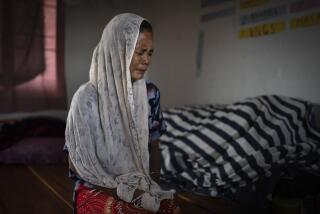Famine Sparked Revolt : Rebel Anger Blooms Into Indian State
- Share via
AIZAWL, India — The Mizo guerrilla uprising began here nearly 30 years ago after the bamboo that covers the vertiginous hillsides of this strange land burst into brilliant yellow flower.
The seeds from the flowers of the thorny bamboo, which blooms only once every 50 years, attracted rats. After gorging on the seeds, the rats multiplied rapidly and swarmed over the countryside in the millions.
They overran the rice crops and invaded the villages, bringing famine and cholera. Thousands of Mizos, the tribal people who live here in the rugged eastern frontier of India between Burma and Bangladesh, died in the terrible, recurring famine that the natives call mautam .
Many Mizos felt the government of India was indifferent to their plight in that 1959 famine.
“New Delhi never took note of the suffering of our people,” said Laldenga, a rebel leader.
3 Decades of Struggle
In 1961, Laldenga--the Mizo customarily use a single name--created the Mizo National Famine Front. In time, the famine reference was dropped and a fighting unit was added, the Mizo National Army.
For almost three decades, the rebels confronted the Indian army and police, laying ambush after ambush for them on the rocky hillsides of this land. In 1966, the Mizo National Army seized and held the mountaintop capital of Aizawl for six days--and had the dubious distinction of being the first indigenous guerrilla movement to be bombed and strafed by the Indian air force.
Now, however, the same Mizo National Front that tormented the Indian army all those years has became the first guerrilla movement to be elected as the ruling party of an Indian state. And last Friday, Mizoram, a majestic land of anticlinal mountains, crisp, clean air and a population of only half a million, became India’s 23rd state in a ceremony presided over by Prime Minister Rajiv Gandhi.
Front Elected to Power
The Mizo National Front defeated Gandhi’s Congress-I party in local elections Feb. 16. The front, fielding a slate of candidates that included former rebel commanders, captured at least 25 of the 40 seats in the state assembly. The new state’s first political leaders will be men who have spent much of the last 25 years fighting and killing Indian soldiers and policemen. The total death toll from all those years of fighting amounts to more than 1,500 men.
Laldenga, 60, the movement’s longtime leader, who has spent many of the last 25 years in exile in Pakistan, China and Britain, was named chief minister, the top political officer.
The rehabilitation and repatriation of the front’s guerrillas was made possible by an agreement signed last June by Laldenga, the Gandhi government and the Congress-I party. Under the agreement, the 800 or so Mizo guerrillas still in the jungle were granted full amnesty. In exchange, the guerrillas promised to surrender their weapons to the government.
The agreement was executed in an emotional ceremony last July. Local authorities melodramatically dubbed the nationally televised occasion “a farewell to arms.” The modishly dressed Mizo guerrillas, carrying automatic assault rifles, rocket-propelled grenades, guitars and videocassette tapes of movies starring the late Chinese martial actor Bruce Lee, emerged from the jungles to parade to Aizawl, the Mizoram capital.
The return of the guerrillas to Mizoram has implications for the six other states of the isolated Indian northeast--Assam, Meghalaya, Arunachal Pradesh, Nagaland, Tripura and Manipur--each of which has a guerrilla movement of its own.
Lalkhama, Mizoram’s chief secretary and top civil servant, said: “The northeastern states are so close--geographically, culturally and economically--that the elections are bound to have an effect in the other places.”
And Laldenga, the chief minister-elect, said: “I believe they are all watching us. Perhaps someday even the Nagas (the fiercest of the rebel groups) will like to negotiate.”
If India could tame its rebellious northeast, it would be accomplishing something the British failed to do in 200 years. As late as 1871, Mizo headhunters were still killing British settlers. In that year, a tea planter named James Winchester was decapitated by a Mizo hunter, who took his head home as a trophy.
Veneer of Christianity
Today, much of the tribal culture is hidden beneath the veneer of fundamentalist Christianity, but in those days it was believed that a man could not enter heaven unless he had slept with a virgin and taken the head of an enemy.
The 26 million people of the Indian Northeast, the seven states between Bangladesh, Burma and China, have little in common with Indians in the culturally dominant, densely populated Ganges basin.
The Mizos of Mizoram, for example, are former headhunters who were converted to fundamentalist Christianity by Welsh missionaries 90 years ago. They worship in the stern, spare settings of Welsh Presbyterian, Baptist and Seventh-day Adventist churches. They sing traditional Christian hymns, translated into their own language, to rhythms pounded out on native drums.
The Mizos seldom listen to classical Indian songs but adore American country and western music. Willie Nelson is especially popular. Recently, foreign journalists allowed into the area for the first time in more than 20 years were treated at a party to a remarkable performance of American country songs, including a rendition of “Help Me Make It Through The Night” that was sung by a Mizo girl in a perfect Texas twang.
Modern Dress for Young
The young dress like Bruce Lee or Mad Max, the hero of the biker movies set in a post-nuclear holocaust Australia.
There are many other cultural differences between the Mizo and mainstream India. Most of India, for example, still uses the dowry system: A bride’s parents must provide a sizable payment to the groom’s family. But the Mizo use a “bride price” system: the groom must pay the bride’s parents--usually about $20--for the privilege of marrying their daughter.
And the Mizo, like other peoples in the Northeast, are racially distinct from people elsewhere in India, more akin to the Burmese and Thais than the Indian Aryans or Dravidians. As a result, many Mizo feel alienated and persecuted in mainstream India.
“When we visit Delhi, usually the people take us to be foreigners from Thailand,” Laldenga said.
The rebel leader, nattily dressed in an English black pin-striped suit with red paisley silk tie, cited as an example the time he went to a tailor in New Delhi to have a suit made.
Tailor Lost Interest
As long as the tailor thought he was a foreigner, he said, he was fawned over and the work was done carefully. As soon as he revealed that he was an Indian from the territory of Mizoram, the tailor lost interest. The suit was unacceptable.
“He made me look like a clown,” Laldenga said.
Many here argue that the 30-year struggle of the Mizo rebels, who lived in camps inside neighboring Bangladesh and Burma, was mainly an effort to draw attention to the separate identity of Mizos in India.
“Our cause was not a fight for independence,” said Cahawngzuala, 47, a rebel leader who spent 20 years in the Bangladesh hills before coming home with other rebels in July. “It was so (that) the small Mizo community will be safe economically, politically and socially.” One of the main conditions of their agreement with the Gandhi government was that all outsiders, foreigners and Indians alike, be required to have special permits, issued by the Mizoram government to visit here. Mizos refer to other Indians as vais --outsiders.
The Mizo fears were based mainly on the situation in neighboring Tripura state, where the indigenous tribal population is now outnumbered by outsiders, mainly Hindus from Bengal. Mizoram, which has rich mineral and hydroelectric potential, is one of the few places in India that is both fertile and sparsely populated.
Fear for Their Land
The main Mizo fear is that as India becomes more densely populated, its leaders will cast covetous eyes on Mizoram’s open spaces.
“Here is a land where there is no population pressure,” said Lalkhama, the chief secretary. “We have about 60,000 families making a living on over 5 million acres of land, practically all of which is arable. It is possible in Mizoram to make every family prosperous. It is quite possible.”
Mizoram is an undeveloped, underpopulated land on the edge of the world’s most overworked, overpopulated territory. It has only one paved highway. Its only airport is a flattened mountaintop that can only accommodate small propeller aircraft and helicopters. Yet every valley in its six parallel mountain ranges is a potential source of hydroelectric power. Geologists have recently completed surveys that strongly suggest substantial oil and gas reserves.
Still, the leaders of India’s new state are not ready to open the doors to their fellow countrymen.
“We cannot afford to share,” Lalkhama said.
Laldenga agreed, cautioning, “If we open our doors completely, the whole of India will rise and we will become a minority in our own state.”
More to Read
Sign up for Essential California
The most important California stories and recommendations in your inbox every morning.
You may occasionally receive promotional content from the Los Angeles Times.












